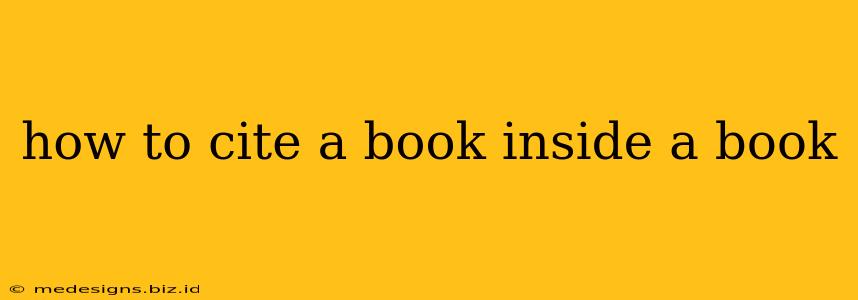How to Cite a Book Inside a Book: A Comprehensive Guide
Citing a book within another book requires a nested citation, acknowledging both the original source and the secondary source where you found the information. This ensures academic integrity and allows readers to easily locate the original work. This guide provides a clear and comprehensive explanation of how to handle this in different citation styles.
Understanding Nested Citations
A nested citation occurs when you're referencing information found in one source (your secondary source) but that information originally comes from another source (your primary source). Simply citing the secondary source isn't sufficient; you need to indicate where the information originated. This prevents misrepresentation and ensures proper attribution.
Why is this important? Because you didn't read the original source yourself; you're relying on the author of your secondary source's interpretation and presentation of that information.
Common Citation Styles & Their Approach
Different citation styles (MLA, APA, Chicago, etc.) have slightly different formatting rules. However, the core principle—giving credit to both sources—remains consistent. Let's look at how to handle this in some popular styles:
1. MLA (Modern Language Association)
In MLA, you'll cite the primary source in the text, but list only the secondary source in your "Works Cited" page.
-
In-text citation: (Author of primary source, year cited in secondary source, page number in primary source as cited in secondary source).
- Example: (Smith 1998, 25 as cited in Jones 2023, 10). This indicates you got the information from Smith's 1998 work (page 25), but you read about it in Jones's 2023 book (page 10).
-
Works Cited: Only list Jones's book in your Works Cited page.
2. APA (American Psychological Association)
APA follows a similar pattern to MLA regarding nested citations.
-
In-text citation: (Author of primary source, year, as cited in Author of secondary source, year, page number).
- Example: (Smith, 1998, as cited in Jones, 2023, p. 10).
-
References: Only Jones's book will appear in your References list.
3. Chicago (Turabian)
The Chicago style offers slightly different approaches depending on the type of note used (footnotes or endnotes).
-
Footnotes/Endnotes: You'll cite both the primary and secondary sources. The secondary source will be the primary citation, and the primary source will follow in parentheses.
- Example: ¹Jones, Book Title, 10 (citing Smith, Book Title, 25).
-
Bibliography: Only the secondary source (Jones's book) will be listed in the bibliography.
Important Considerations:
- Accuracy: Always double-check the accuracy of information you’re citing, even if it comes from a reputable secondary source.
- Accessibility: If possible, try to locate and read the primary source. This will give you a better understanding of the information and avoid potential misinterpretations.
- Transparency: Clearly indicate when you’re using a secondary source to avoid plagiarism.
Best Practices for Nested Citations
- Consistency: Maintain consistency throughout your work in how you handle nested citations.
- Clarity: Ensure your citations are clear and easy to understand. Avoid ambiguity.
- Reference Management Software: Utilize citation management tools (like Zotero, Mendeley, or EndNote) to simplify the process and minimize errors. These tools can help manage and format your citations accurately.
By following these guidelines, you can effectively and accurately cite books within books, demonstrating proper academic rigor and ensuring your work is free of plagiarism. Remember to always consult your specific style guide for the most precise formatting instructions.
